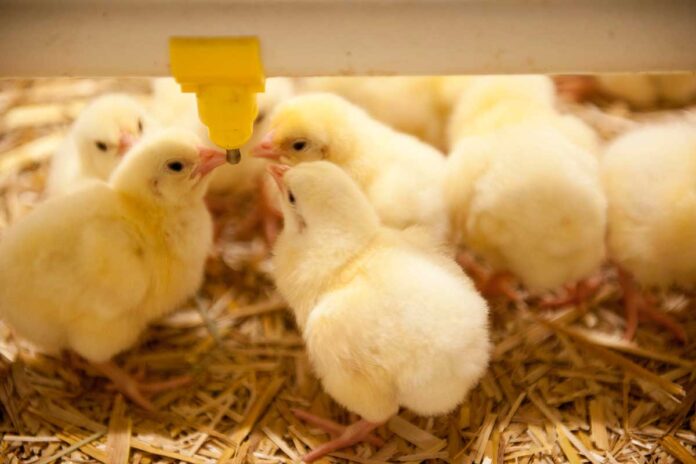
Getting chicks off to a good start is very important to overall flock performance. At no time does a bird grow faster than during the first week of its life.
Connie Mou, Ph.D. Poultry Environmental Management,
Michael Czarick, Extension Engineer
Jones-Hamilton, Agricultural Division, University of Georgia
Over the last week of a 42-day-old flock, a bird’s weight will increase by approximately a third. In contrast, a chick’s weight will typically increase approximately four-fold, possibly more, by the time it reaches seven days of age. Of course, if a chick is going to grow this quickly it has to eat plenty of feed. Research has shown that over the first full day of a chick’s life it will eat approximately 1/4 of its weight in feed. By the end of the first week, a 40-gram chick (0.09 lbs) will eat approximately 0.33 lbs of feed and gain approximately 0.31 lbs, giving it a feed conversion ratio of approximately 1.1 lbs of gain/lbs. of feed (Alqhtani, 2016).
This very high growth rate during the first week is only achievable if the chicks have access to plenty of water. A chick will not eat, and therefore will not grow, if it cannot drink. In the previously noted study it was found that during the first few days of a flock, a chick will drink nearly three grams of water for every gram of feed. By the end of the first week each chick in a house will drink approximately 12 ounces of water. This is over eight times their initial weight in water.
Being able to accurately track how much chicks drink can be instrumental towards understanding how well they are performing. Though there are many other ways to measure chick performance, most are unrealistic or far too expensive. Bird scales could be used to monitor chick weight, but will cost thousands of dollars per house to install. Bin/dump scales are a common, though costly, method of monitoring bird feed consumption but are not very effective with young chicks due to the very low rate at which feed is being drawn from feed bins.
On the other hand, a relatively inexpensive water meter can be used by producers to provide a fairly accurate, indirect measure of feed consumption as well as a rough idea if chick weights are ahead or behind where they should be. A flock’s daily water usage can provide a rough idea if the chick water usage, and therefore feed consumption, is on target. More importantly, through daily monitoring and recording of water usage, a historical record can be developed that future flocks can be compared.
Is a house ahead or behind the historical average for a given day? If it is behind, corrective actions (adjusting drinker height, house temperatures, feed availability, etc.) may need to be taken before bird performance suffers. If it’s ahead of the average then a producer might want to take a few moments to consider what may be different this particular flock.
It is important to note that water consumption during the first week can be low simply due to the fact the chicks are small. Smaller chick will tend to eat less starting off than larger chicks. This doesn’t mean over time they can’t catch up. With smaller chicks it is important to provide extra special care to insure they get off to a good start. Since small chicks tend to have lower body temperatures and an increased rate of heat loss, house temperatures may need to be increased. Drinker lines may have to be set closer to the ground and feed area increased (ie. feeder paper). Monitoring daily water usage can provide important insight into how the small chicks are progressing.
As with any monitoring tool, accuracy is crucial. The vast majority of poultry house water meters do a good job of accurately measuring water usage once the birds are a roughly week old, but struggle with measuring water usage the first few days of flock. To measure water usage during the first few days of a typical flock (approximately 24,000 birds), a water meter needs to be able to measure water flow rates down to at least 0.25 gals/min, ideally 0.10 gals/min. Meters with the ability to measure flow rates of 0.10 gals/min are typically able to accurately measure flock water usage on Day 1. Those only capable of measuring flow rates of 0.25 gals/min or higher were typically not able to accurately measure flock water usage until Day 2 or 3. As you might expect, the larger the house, the greater the number of birds, the easier it is to measure chick water usage on Day 1.
Being able to accurately measure water usage during the first few days of a chick’s life can be of tremendous benefit. Generally speaking, the more water the chicks are drinking, the better they are doing. If water usage is lower than that seen during previous flocks, it typically means the chicks are eating less in previous flocks, and therefore growing less. Maybe the house is too hot. Maybe it’s too cold. Maybe there is something wrong with the drinker system. Regardless of the cause, having a water meter capable of accurately measuring chick water usage is one of the best and most inexpensive methods of providing a farm manager an indicator of how good of a job they are doing getting their flock off to as good of a start.

















